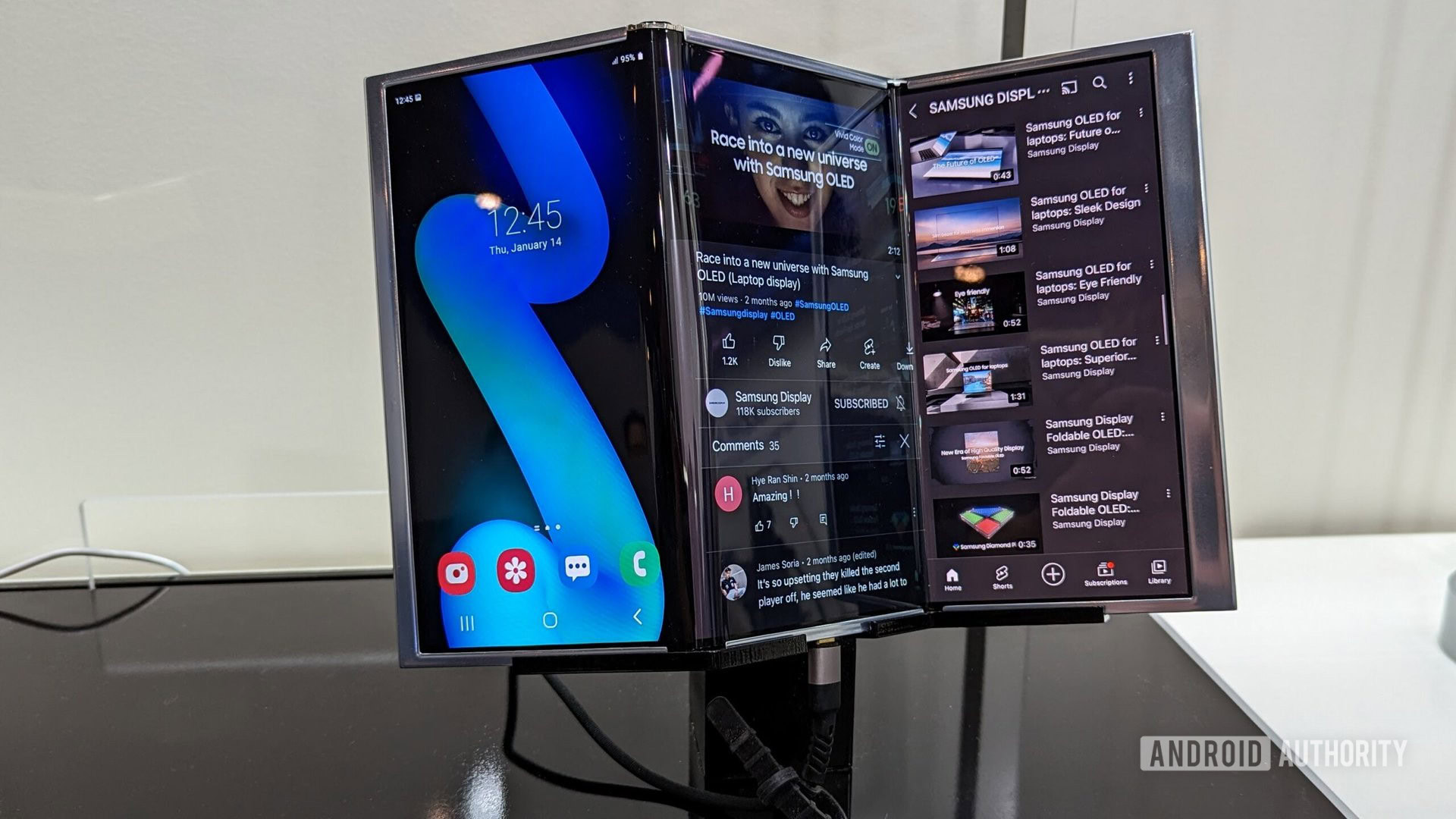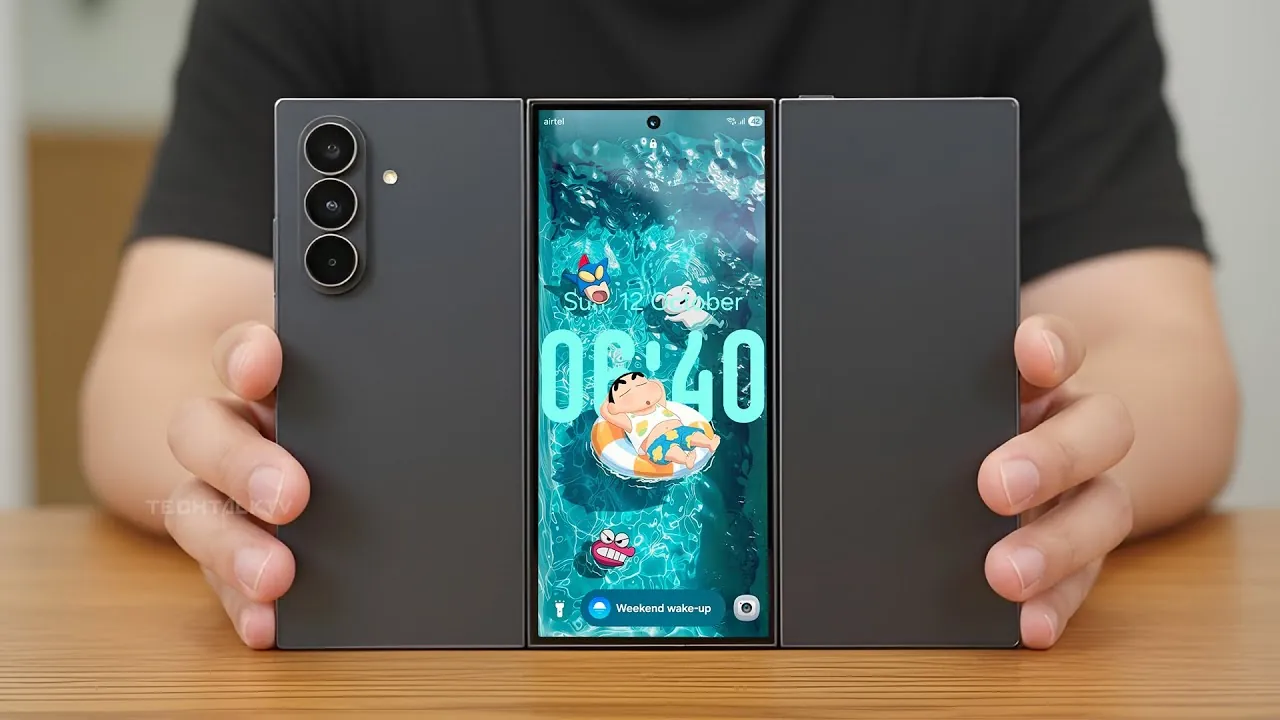

Samsung has taken a major step in the foldable phone market by publicly showcasing its first tri-fold smartphone. The device—believed to be titled the Galaxy Z TriFold—was displayed at a recent event in South Korea, giving the world a first real glimpse of a phone that folds not once, but twice. (TechRadar)
Here’s everything we know so far: what it is, why it’s important, where it stands for U.S. users, and what to watch for.
What We Know About the Device
-
The Galaxy Z TriFold was publicly displayed behind glass at the Asia-Pacific Economic Cooperation (APEC) Summit in Korea. No hands-on demo yet — attendees couldn’t fold it themselves. (The Verge)
-
Leaked details suggest a 6.5-inch cover screen when folded and a massive ≈10-inch display when fully unfolded — effectively turning the phone into a tablet. (TechRadar)
-
The fold mechanism uses two hinges and three display panels (hence “tri-fold”), with each side folding inward in a “G-shape” rather than an outward fold style. (Android Central)
-
Samsung has not yet confirmed the full specs, price, or whether the U.S. launch will happen immediately. Early reports suggest an initial launch in select Asian markets. (Android Central)
Why This Matters
-
Innovation in form factor: While foldable phones (book-style or clamshell) are already in the market, a tri-fold phone represents a new layer of design and engineering complexity — and potentially a new way to use a phone as a tablet.
-
Samsung’s leadership push: Samsung is clearly positioning itself at the forefront of foldable tech. By showcasing a tri-fold model, it signals that it’s willing to push into premium, niche devices that may set the stage for future mainstream versions.
-
User experience implications: A device with a 10-inch unfolded display means enhanced multitasking, bigger screen for video/gaming, and tablet-like productivity all in one. For users who often switch between a phone and a tablet, this form could be a major benefit.
-
Market differentiation: With increasing competition in foldables from other brands, this tri-fold could help Samsung stand out — at least in the premium segment.
Considerations for U.S. Users
If you’re in the United States and considering this device (or tracking it), keep these points in mind:
-
Availability uncertain: As of now, it appears the initial launch may focus on Asian markets such as Korea, China, Taiwan, Singapore and UAE. U.S. availability might either come later or in limited numbers. (Android Central)
-
Price likely high: Given its advanced form factor, the tri-fold phone is expected to cost considerably more than current high-end foldables. One source estimates it could exceed US$3,000. (Gizmodo)
-
Early adopter risks: First-generation devices carry more uncertainty — things like durability of hinges, software optimization for the new form, accessory ecosystem, and long-term service/support might lag behind.
-
Size & portability trade-offs: With a large 10-inch display unfolded and multiple hinges, the device may be thicker/heavier than traditional phones. That can impact how comfortable it is for everyday use.
-
Ecosystem readiness: Apps and UI may need to adapt to tri-fold screens. Samsung will likely use a tailored version of its One UI software to handle multi-panel workflows, but developers might lag behind.
What’s Next & What to Watch For
-
Official launch date & regions: Samsung is expected to give full launch details soon — including availability date, markets, and how many units will be produced. When Samsung says it plans to “bring next-gen device to users this year”, that suggests a late-2025 release window. (The Verge)
-
Pricing announcements: Will the tri-fold cost significantly more than the current foldable flagships? How does this compare to competitors?
-
Durability testing: As with prior foldables, hinge reliability, screen durability (especially with more folds), and long-term battery life will need to be proven in real-world use.
-
Software and UI experience: Does the tri-fold hinge into new usage modes (tablet → phone → compact) smoothly? Does Samsung update Samsung Apps/One UI optimally for three-panel folding?
-
Launch in U.S. & global markets: Samsung may choose to keep the tri-fold as a limited market device initially. If you live outside the initial launch markets, you’ll want to check import/back-home support, warranty, and service options.
-
Competition response: Other brands may accelerate tri-fold or new hinge form factors in response. Samsung could be aiming to set the benchmark.
Why Some May Wait — And Others Might Upgrade
Reasons to wait:
-
If you’re using a current flagship phone that still meets your needs, you might prefer to wait until the tri-fold form matures and prices drop.
-
If you find high cost, uncertainty about availability or early generation bugs concerning, waiting for second-generation tri-folds may make sense.
-
If portability and compactness are higher priorities than large screen size, a normal phone might serve you better.
Reasons to upgrade:
-
If you regularly multitask, use a tablet and phone separately, or value a large display for productivity or media, the tri-fold offers something new.
-
If you like being an early adopter and experiencing the latest design innovations, this is among the most cutting-edge devices this year.
-
If you are invested in the Samsung ecosystem and can take advantage of the bigger screen and multi-window workflows, the tri-fold could unlock new use cases.
Final Thoughts
Samsung’s public showing of its first tri-fold smartphone is a clear signal: the foldable phone market is evolving beyond simple book-style folds. The Galaxy Z TriFold (or whatever it ends up officially named) could become a new class of device — blending phone and tablet experiences in one.
For U.S. users, the next few weeks/months will be key: will Samsung bring this model to the U.S. quickly, how will the price land, and how transferable will its features be to everyday usage? If you value large screens, flexibility and the cutting edge, this device is worth watching. If you favour value, reliability and compact size, it may be wiser to wait for the second generation.
